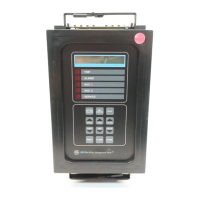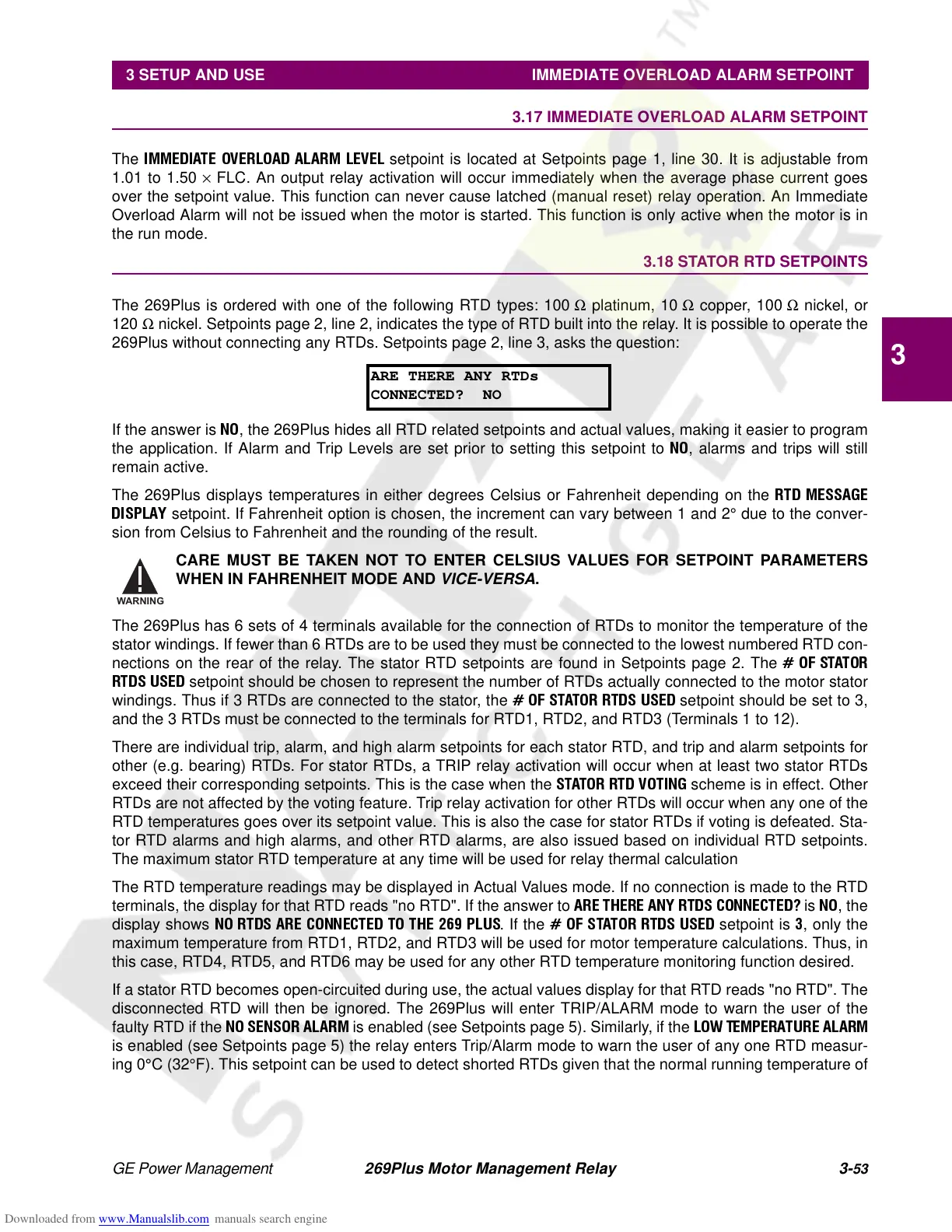GE Power Management 269Plus Motor Management Relay 3-
53
3 SETUP AND USE IMMEDIATE OVERLOAD ALARM SETPOINT
3
3.17 IMMEDIATE OVERLOAD ALARM SETPOINT
The
IMMEDIATE OVERLOAD ALARM LEVEL
setpoint is located at Setpoints page 1, line 30. It is adjustable from
1.01 to 1.50 × FLC. An output relay activation will occur immediately when the average phase current goes
over the setpoint value. This function can never cause latched (manual reset) relay operation. An Immediate
Overload Alarm will not be issued when the motor is started. This function is only active when the motor is in
the run mode.
3.18 STATOR RTD SETPOINTS
The 269Plus is ordered with one of the following RTD types: 100 Ω platinum, 10 Ω copper, 100 Ω nickel, or
120 Ω nickel. Setpoints page 2, line 2, indicates the type of RTD built into the relay. It is possible to operate the
269Plus without connecting any RTDs. Setpoints page 2, line 3, asks the question:
If the answer is
NO
, the 269Plus hides all RTD related setpoints and actual values, making it easier to program
the application. If Alarm and Trip Levels are set prior to setting this setpoint to
NO
, alarms and trips will still
remain active.
The 269Plus displays temperatures in either degrees Celsius or Fahrenheit depending on the
RTD MESSAGE
DISPLAY
setpoint. If Fahrenheit option is chosen, the increment can vary between 1 and 2° due to the conver-
sion from Celsius to Fahrenheit and the rounding of the result.
CARE MUST BE TAKEN NOT TO ENTER CELSIUS VALUES FOR SETPOINT PARAMETERS
WHEN IN FAHRENHEIT MODE AND
VICE-VERSA
.
The 269Plus has 6 sets of 4 terminals available for the connection of RTDs to monitor the temperature of the
stator windings. If fewer than 6 RTDs are to be used they must be connected to the lowest numbered RTD con-
nections on the rear of the relay. The stator RTD setpoints are found in Setpoints page 2. The
#OFSTATOR
RTDS USED
setpoint should be chosen to represent the number of RTDs actually connected to the motor stator
windings. Thus if 3 RTDs are connected to the stator, the
# OF STATOR RTDS USED
setpoint should be set to 3,
and the 3 RTDs must be connected to the terminals for RTD1, RTD2, and RTD3 (Terminals 1 to 12).
There are individual trip, alarm, and high alarm setpoints for each stator RTD, and trip and alarm setpoints for
other (e.g. bearing) RTDs. For stator RTDs, a TRIP relay activation will occur when at least two stator RTDs
exceed their corresponding setpoints. This is the case when the
STATOR RTD VOTING
scheme is in effect. Other
RTDs are not affected by the voting feature. Trip relay activation for other RTDs will occur when any one of the
RTD temperatures goes over its setpoint value. This is also the case for stator RTDs if voting is defeated. Sta-
tor RTD alarms and high alarms, and other RTD alarms, are also issued based on individual RTD setpoints.
The maximum stator RTD temperature at any time will be used for relay thermal calculation
The RTD temperature readings may be displayed in Actual Values mode. If no connection is made to the RTD
terminals, the display for that RTD reads "no RTD". If the answer to
ARE THERE ANY RTDS CONNECTED?
is
NO
,the
display shows
NO RTDS ARE CONNECTED TO THE 269 PLUS
.Ifthe
# OF STATOR RTDS USED
setpoint is
3
, only the
maximum temperature from RTD1, RTD2, and RTD3 will be used for motor temperature calculations. Thus, in
this case, RTD4, RTD5, and RTD6 may be used for any other RTD temperature monitoring function desired.
If a stator RTD becomes open-circuited during use, the actual values display for that RTD reads "no RTD". The
disconnected RTD will then be ignored. The 269Plus will enter TRIP/ALARM mode to warn the user of the
faulty RTD if the
NO SENSOR ALARM
is enabled (see Setpoints page 5). Similarly, if the
LOW TEMPERATURE ALARM
is enabled (see Setpoints page 5) the relay enters Trip/Alarm mode to warn the user of any one RTD measur-
ing 0°C (32°F). This setpoint can be used to detect shorted RTDs given that the normal running temperature of
ARE THERE ANY RTDs
CONNECTED? NO
WARNING

